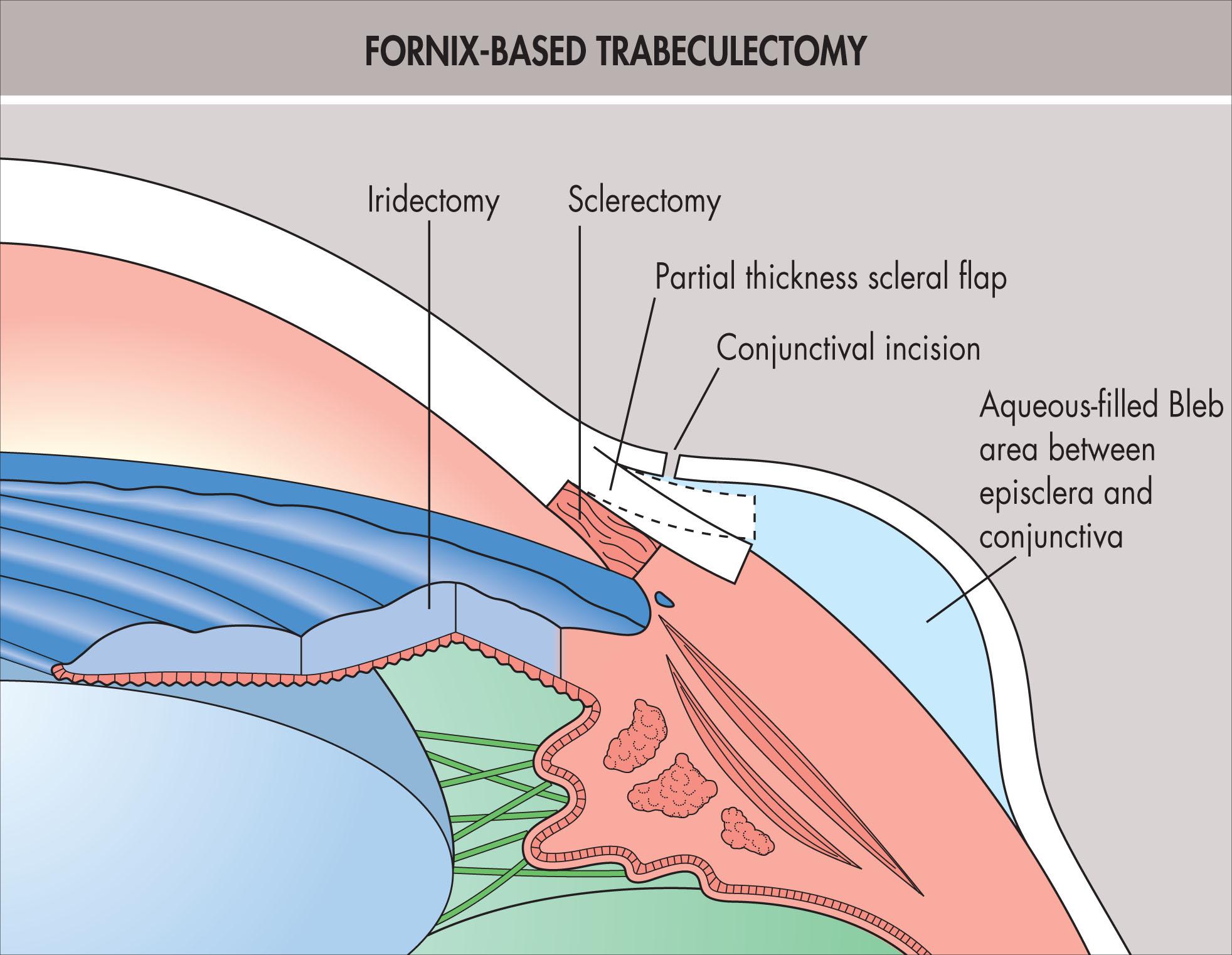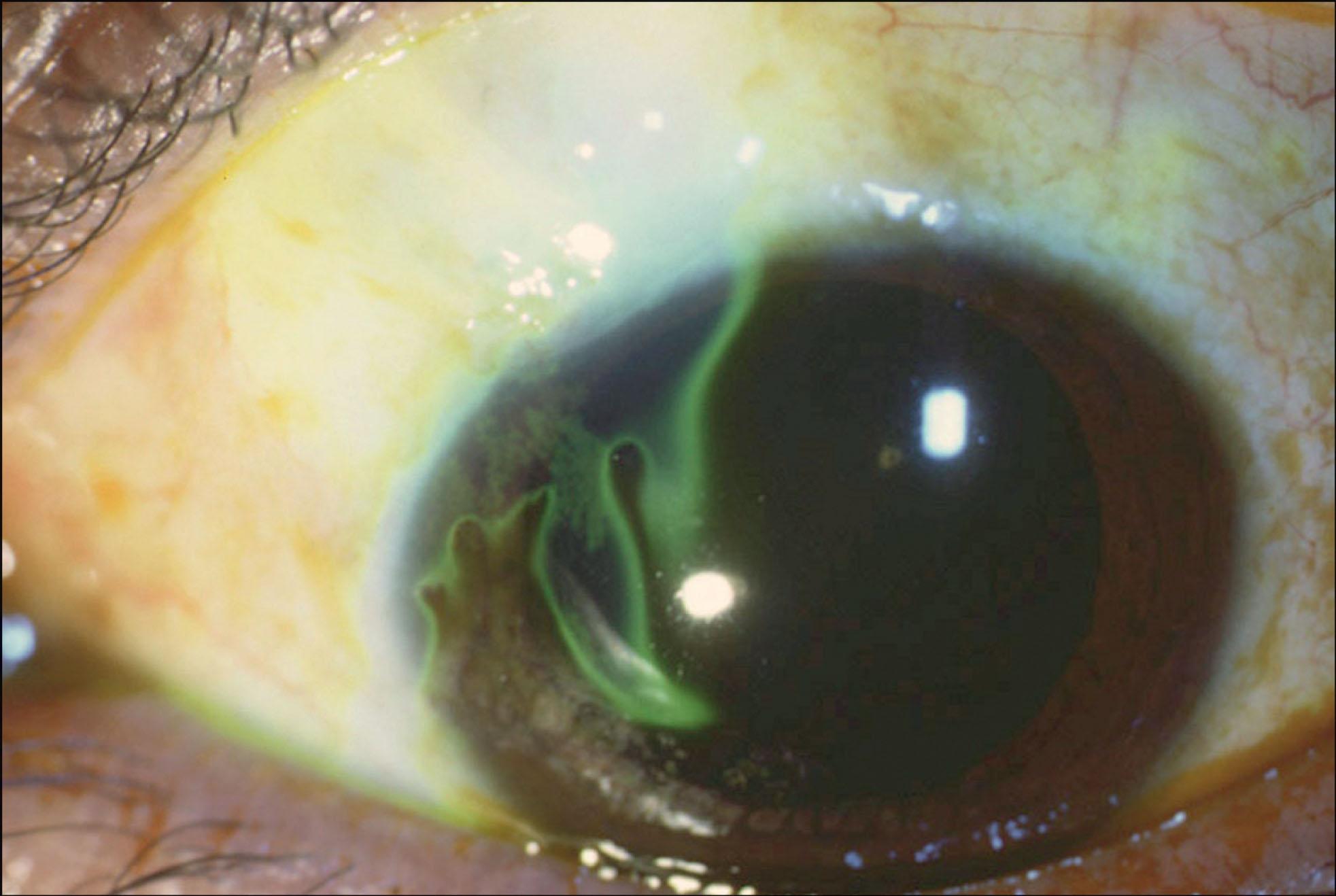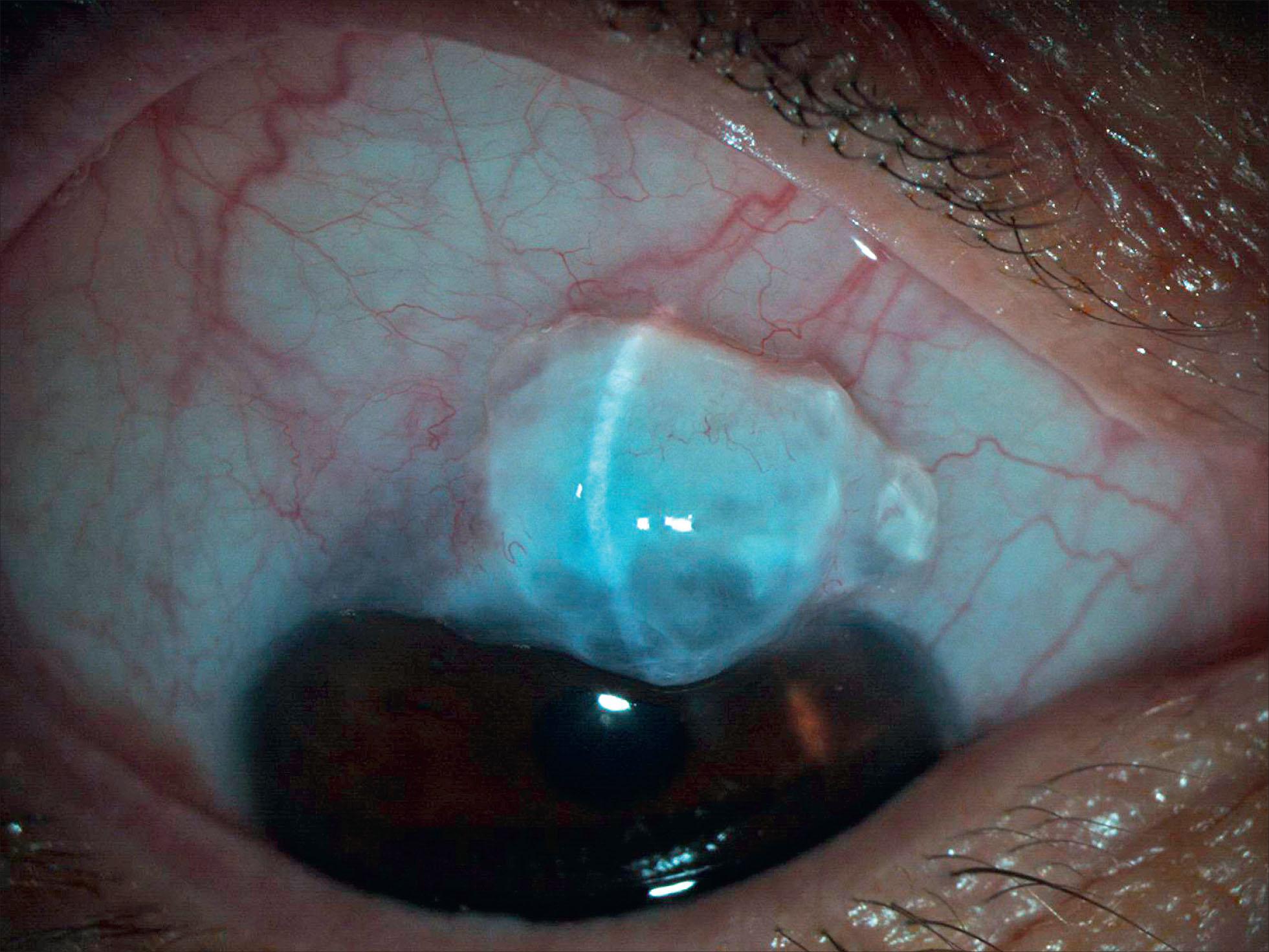Physical Address
304 North Cardinal St.
Dorchester Center, MA 02124
![]()
A surgical procedure featuring a partial-thickness scleral flap that creates a fistula between the anterior chamber and the subconjunctival space for filtration of aqueous fluid and the creation of a conjunctival bleb in an effort to lower intraocular pressure.
Bleb formation occurs.
When successful, decreases intraocular pressure significantly from preoperative levels.
Wound healing influences success.
Meticulous intraoperative technique is required.
Intense postoperative observation and management are necessary.
Antimetabolites (mitomycin C or 5-fluorouracil).
Hypotony.
Choroidal detachment.
Bleb leak.
Bleb-associated endophthalmitis.
Trabeculectomy is the most common form of modern filtration surgery used to lower intraocular pressure (IOP) in a patient with glaucoma. In trabeculectomy, a fistula for aqueous fluid is created between the anterior chamber and the subconjunctival space, beneath a partial-thickness scleral flap, to create an area of “filtration” called the bleb . Trabeculectomy techniques have evolved from full-thickness sclerectomy forms of filtration surgery to minimize postoperative complications while achieving the goal of successful lowering of IOP. With all forms of filtration surgery, the most sight-threatening complications, such as suprachoroidal hemorrhage, occur in the setting of hypotony. Surgeons embraced trabeculectomy as a way to avoid hypotony, yet historically, the move to trabeculectomy from full-thickness filtration surgery was gradual, as techniques were developed to achieve ultimate success and adequate IOP lowering for the long term.
Trabeculectomy was originally described by Cairns in 1968 and has continued to be modified as surgical instrumentation and suture have improved in recent decades. Modalities to alter wound-healing fibrosis in the subconjunctival space, such as use of antimetabolites (5-fluorouracil and mitomycin C) and laser suture lysis, have continued to offer improvements in postoperative success. Trabeculectomy is still considered the gold standard surgery for primary glaucoma filtration because it is effective, relatively low risk, and technically within the skills of the well-trained ophthalmic surgeon. Variations of technique among surgeons and variability in wound healing among patients are the norm, and it is said that astute and careful postoperative management by the surgeon is key to the successful outcome of trabeculectomy for a patient.
It is helpful to understand the anatomy of a trabeculectomy to recognize the optimal conditions for successful surgery. In many ways, the trabeculectomy is a complicated series of “incisions,” most of which must remain free from healing or scarring to establish a functional filtration bleb. In fact, the only incision that requires complete healing is the conjunctival incision, either at the limbus in a fornix-based flap or at the fornix in a limbal-based flap. Otherwise the iridectomy, sclerectomy, underside of the partial-thickness scleral flap, the sides of the scleral flap, and the extremely important surface area between the episclera and conjunctiva must remain free of obstruction to allow aqueous fluid to migrate through the fistula ( Fig. 10.27.1 ).

Although the goal in trabeculectomy is to establish a subconjunctival filtration bleb that lowers the IOP sufficiently, the bleb itself is the cause of many of the late-onset complications that may occur. Blebs can leak, become infected, and induce endophthalmitis, or cause chronic discomfort ( Fig. 10.27.2 ). Antimetabolite use increases the risk of leaking and infection because of the permanent changes in the conjunctiva that promote a thin-walled bleb ( Fig. 10.27.3 ). Yet antimetabolites offer a more successful long-term decline of IOP in patients who are at high risk for filtration failure and in primary trabeculectomies. It is the risks of the established bleb that have led to the development of non–bleb-forming filtration surgeries. The main disadvantage of non–bleb-forming procedures, where aqueous is shunted to alternative outflow pathways, such as the episcleral venous system or suprachoroidal space, is lowering of IOP to a less significant level that may not be adequate in some patients and may still allow glaucoma progression to occur ( Table 10.27.1 ). Newer devices that allow access to the subconjunctival space with minimal or no (via ab interno insertion through the angle) incisions in the conjunctiva have also been instituted in an attempt to improve the morphology of the bleb and minimize complications. In recent years, after publication of the findings of the randomized Tube Versus Trabeculectomy Study for eyes with previous surgery, as well as the Primary Tube Versus Trabeculectomy Study, surgeons are recognizing that glaucoma drainage implant surgery may rival or improve on the long-term results of trabeculectomy, although controversy remains about the complication profile for each procedure and the ideal surgical procedure for advanced glaucoma.


| Advantages | Disadvantages |
|---|---|
| Trabeculectomy | |
| Proven long-term success | Wound-healing reaction important |
| Technical skills moderate | Creates a bleb—risk for infection |
| Gold standard | Creates a bleb—risk for discomfort |
| Relatively low risk of hypotony | Duration of effect—limited |
| Instrumentation readily available | More postoperative interventions: laser suture-lysis, 5-fluorouracil injections |
| Non–Bleb Filtration Surgery | |
| Low risk of hypotony | Less intraocular pressure decline long term Fewer published reports on long-term success |
| No bleb or bleb complications | Some techniques are more technically difficult, time-consuming in operating room |
| Need postoperative interventions: iridotomy, Descemet's puncture | |
| Additional instrumentation and/or devices | |
The goal of glaucoma management is to preserve visual function while maintaining or improving the patient's quality of life. When surgery is necessary, trabeculectomy is the procedure of choice for most cases of severe primary glaucomas. Success in glaucoma surgical studies is usually reported as a final IOP <21 mm Hg and/or 30% decrease in IOP, with or without additional medications, even though for many eyes that undergo trabeculectomy the goal is for postoperative IOP control in the low teens. Success with the typical definition in forms of open-angle glaucoma and primary angle-closure glaucomas has been reported in approximately 80% of eyes over 1–2 years, with lower IOP achieved with antimetabolite use. Relatively few studies have evaluated the long-term preservation of visual field and optic nerve function as an outcome measure, yet it seems that glaucoma surgery is successful in this regard for the majority of eyes that have resulted in successful control of IOP.
The decision to offer trabeculectomy is based on the patient's current stage of their glaucoma and the risks for ongoing progression of the disease without further intervention. The rate of progression differs among patients, as does the goal for IOP control. Each individual must be carefully evaluated as to the best treatment modality. Some patients are likely to need trabeculectomy soon after diagnosis of their glaucoma, yet there are many patients who will never need trabeculectomy even after many years of the disease ( Box 10.27.1 ).
Intraocular pressure (IOP) too high to prevent future glaucoma damage and functional visual loss
Documented progression of glaucoma damage at current level of IOP with treatment
Presumed rapid rate of progression of glaucoma damage without intervention
Poor compliance with medical therapy: cost, inconvenience, understanding of disease, refusal
Intolerance to medical therapy because of side effects
Surgical planning begins in the office with a careful history, ocular examination, and review of the patient's risk factors for failure ( Table 10.27.2 ). On the basis of this assessment the surgeon will plan the approach to surgery, including fornix-based or limbal-based conjunctival flap dissection, placement of the scleral flap and sclerostomy, need for and type of antimetabolite, tightness of the scleral flap sutures to titrate the amount of aqueous fluid egress in the early postoperative period, need for releasable scleral flap sutures, and any preoperative treatments.
| Average Risk | Moderate Risk | High Risk |
|---|---|---|
| POAG | JOAG | Childhood onset |
| Pseudoexfoliation glaucoma | Pigmentary glaucoma, mainly due to younger age of patient | Neovascular glaucoma—inflamed eye |
| Mixed mechanism | Blunt trauma, angle recession | Uveitis, inflammatory |
| Prior clear cornea phacoemulsification | Conjunctival scarring after phacoemulsification | Conjunctival scarring after ECCE, ICCE |
| Neovascular glaucoma—quiet eye | Conjunctival scarring after vitreoretinal surgery | |
| Fellow eye with encapsulated bleb | Fellow eye failed filter | |
| Combined with phacoemulsification | Prior filter failed | |
| After acute angle closure | Perforating/penetrating traumas | |
| Corticosteroid-induced glaucoma | ICE syndrome | |
| Chronic angle-closure glaucoma | Epithelial downgrowth | |
| Elderly | Middle age | Youth |
| White, Asian | Hispanic, African descent |
Preoperative factors that need to be considered are given in Table 10.27.3 .
| Location | Finding | Considerations |
|---|---|---|
| External/adnexa | Abnormal lid position or lagophthalmos | Increases risk for exposure, thinning, discomfort, and infection of blebIf prior blepharoplasty/ptosis repair, conjunctival fornix may be under tension |
| Blepharitis | Increases risk for infection in the early and late postoperative periods | |
| Conjunctiva | Allergy, toxicity | Discontinue any drops causing topical toxicity for several weeks before surgery. Consider preoperative topical corticosteroids to quiet eye |
| Dry eye, keratoconjunctivitis sicca | Should be treated. Punctual plugs, omega-3s, and cyclosporin are considered. May be more at risk of infection in the early or late postoperative period | |
| Conjunctival scarring a | Prior pterygium or tumor removal | Less mobile conjunctiva overall and scarring nasally |
| Prior ECCE surgery | Entire limbal area, conjunctiva and sclera, may be scarred | |
| Prior scleral tunnel phacoemulsification | Localized area of limbal scarring, may be able to position trabeculectomy flap to one side of tunnel | |
| Prior pars plana vitrectomy | Localized areas of conjunctiva scarring posterior to limbus and/or entire limbal area may be scarred | |
| Prior scleral buckle | Entire limbal and posterior conjunctiva is scarred | |
| Trauma | Careful inspection for wound, scarring | |
| Cornea | History of herpes simplex virus infection | Consider antiviral coverage during the postoperative period |
| Prior penetrating or endothelial keratoplasty | Position trabeculectomy to avoid encountering host–graft interface or peripheral anterior synechiae | |
| Anterior chamber | Uveitis | Treat aggressively before and after surgery. Eye often at risk for hypotony because of low aqueous production |
| Iris, angle | Peripheral anterior synechiae | Gonioscopy to locate and avoid |
| Trauma | Avoid sclerostomy near iris dehiscence—may encounter vitreous if zonules absent. Vitrectomy should be considered, if necessary | |
| Neovascularization | Aggressive treatment before surgery with panretinal photocoagulation, anti-VEGF agents, topical corticosteroids and atropine preoperatively, waiting several weeks for trabeculectomy, if possible. Early hypotony should be avoided to minimize hyphema and fibrin postoperatively | |
| Lens | Aphakic | Vitrectomy should be planned; hypotony should be avoided. There is increased risk of suprachoroidal hemorrhage. Sclera is thin, and conjunctival scarring may occur at the limbus |
| Pseudophakic | Sclera is thin at the superior cataract surgery incisionUsually less likely to develop postoperative anterior chamber shallowing | |
| Phakic | Slightly more likely to develop shallow anterior chamber postoperatively. Cataract may develop or progress postoperatively | |
| Refractive errors | Myopia | Sclera may be thin. Patients with moderate to high myopia are at risk for hypotony maculopathy when antimetabolites used |
| Hyperopia | More likely to develop shallow anterior chamber postoperatively. More likely to develop “aqueous misdirection syndrome” | |
| Prior refractive surgery | Patient may have had high myopia (see earlier) | |
| Retina | Comorbid disease | May affect long-term vision; unrelated to glaucoma |
| Patient issues | Uncooperative, poor understanding of directions | Type of anesthesia, block versus general, should be determined. Determination of laser suture lysis or releasable sutures. Family, friends, and caregivers enlisted to help with postoperative regimen and follow-up |
| Noncompliant | Noncompliance may extend to the postoperative follow-up and medication regimens | |
| Unrealistic expectations | Extensive counseling preoperatively and postoperatively |
a Almost all patients who have conjunctival scarring near the limbus should undergo a fornix-based trabeculectomy. Patients with extensive scarring, neovascular glaucoma, or iridocorneal endothelial syndrome may have better success with glaucoma drainage implantation.
Become a Clinical Tree membership for Full access and enjoy Unlimited articles
If you are a member. Log in here